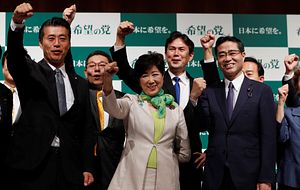On September 27, Tokyo Governor Yuriko Koike launched her new party Kibo no To (Party of Hope). Within 24 hours after the party’s launch, speculations have begun to swirl that the Democratic Party of Japan, struggling to regain public confidence since it lost power in December 2012 despite several attempts to refresh its image with party leadership changes, may dissolve itself, with many of its members joining Koike’s new party.
In the press conference to launch Kibo no To, Koike emphasized the necessity for a “reset” in Japanese politics. She also emphasized that her party will position itself as a “tolerant and reform-minded conservative party that supports tolerance.”
Kibo no To offers a party platform that include six principles. They are: (1) aspiration to become a tolerant conservative party that can remedy the societal divisions pervasive across the world; (2) pursuant of the highest degree of transparency that respect people’s “right to know,” departing from interest group-driven politics; (3) protection of our people’s lives freedom and properties, providing the foundation for everyone to live lives with hopes and energy; (4) realistic diplomatic and national security policy grounded in pacifism; (5) most efficient use of tax revenues and development of sustainable social foundations; and (6) realization of a society where diversity is respected.
The party platform suggests that Koike aims to draw support from two groups of voters. The first group is those who have been frustrated with the Liberal Democratic Party (LDP)-Komeito coalition led by Prime Minister Shinzo Abe, but have continued to vote for the ruling coalition in the absence of attractive alternatives. Her party’s platform has many overlaps with the policy trajectory that the Abe government currently supports. However, the party’s emphasis on “tolerance” is a thinly-veiled criticism against the political method Abe has often used — steamrolling legislation by relying on the solid majority the ruling coalition has enjoyed — to push through his agenda, which invited much criticism even from within the LDP.
The second group of voters Koike seems to be trying to attract are those who believe that a viable opposition party is good and necessary for Japanese politics and yet have been thoroughly disappointed with the Democratic Party of Japan (DPJ). In the last several years, DPJ lost support from this group of voters by degrading into a “party of no.” Its recent decision to cooperate with the Japan Communist Party further alienated some voters. For this group of voters, Koike’s party platform, all of which seems sensible, can offer a credible alternative to the current ruling coalition.
However, as Koike moves ahead with building her party, there are several challenges. The greatest challenge is time. Currently, the Lower House election is anticipated to be announced on October 10, with the voting taking place on October 22. That leaves Kibo no To barely two weeks to work out the election strategy, including determining the electoral districts in which their candidates will run, who will be the officially endorsed candidates, how resources should be prioritized, among other factors critical for the election. These are hard issues for established political parties that have solid party structure and administrative staff support. It will be even more difficult for a party like Kibo no Tono, which is practically a “political party-in-making” at this point.
Secondly, the administrative structure of Kibo no To has yet to be developed. Currently, the party has attracted several high-profile politicians including a former environment minister, Goshi Hosono; a former deputy defense minister, Akihisa Nagashima; a former special advisor to prime minister on abductee issues, Kyoko Nakayama; and former Kanagawa Governor Shigefumi Matsuzawa, among others, with no hierarchical relationship yet established among them. While that can be helpful for the party in encouraging an open and robust debate internally, it is unclear if these members, particularly those who left the DPJ and joined the party, have learned the lesson from one of the biggest factors that contributed to DPJ’s demise: DPJ’s downfall was aggravated precisely because of the inability of its major figures to respect the decisions made by the party leadership. Given that the Koike, albeit being the Chief Representative of the party, is more like a “leader among equals,” it is unclear if the party’s other high-profile members can exercise discipline and maintain a united front on various policy issues.
Finally, Koike herself now has to tread carefully between the responsibility as Tokyo governor and the Chief Representative of Kigo no To. To date, Koike has served only about a third of her three-year term as governor. Since it became clear that she will become “the face” of the new party, criticism about the prospect of her resigning as Tokyo governor and running for a seat in the Lower House herself is quickly surfacing. Whether she appears to be “distracted” from her duties as the governor or she actually decides to resign, she will run the risk of undercutting her credibility, which would also have a negative impact on public perception of her new party.
One thing is for sure. The launching of Kibo no To has dramatically changed the political landscape in which Abe and his ruling coalition will have to campaign next month. Although it is far from certain whether Kibo no To can be a real game changer in Japanese politics, it certainly has the opportunity to shock Abe and his ruling coalition.

































